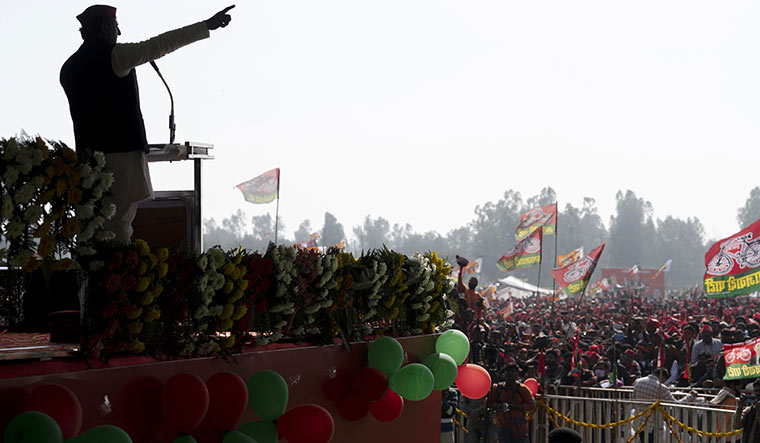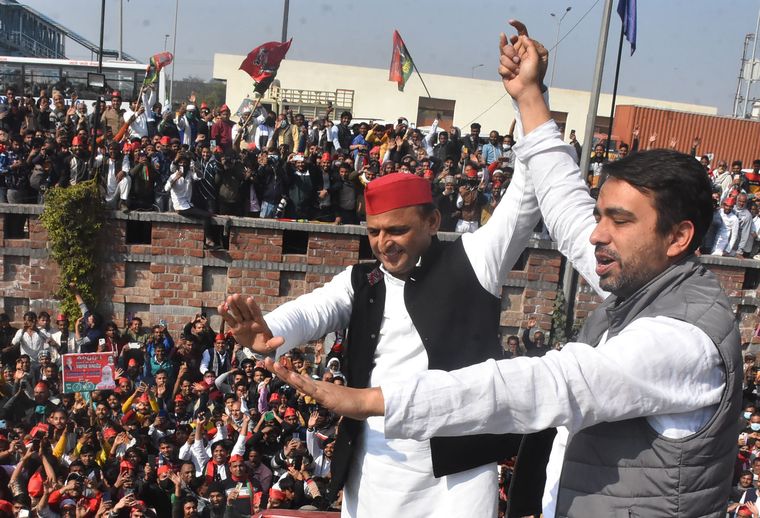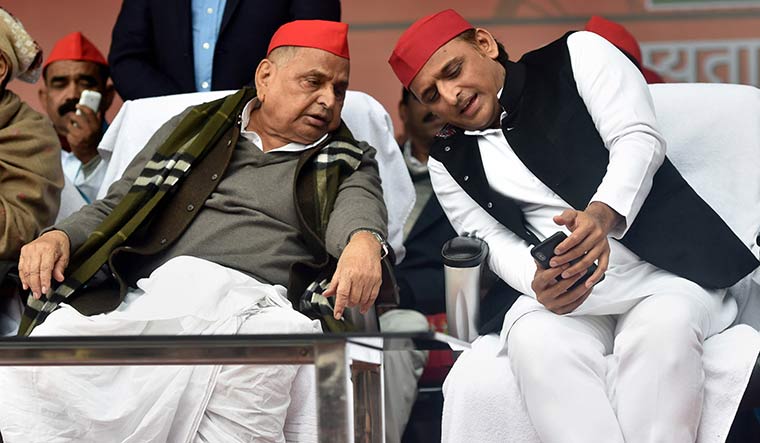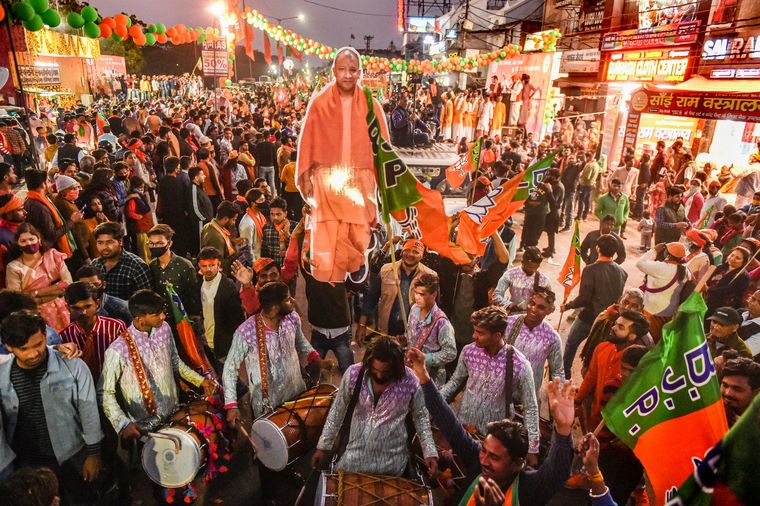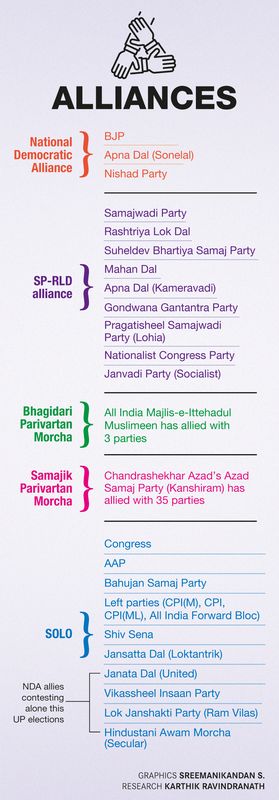Just as in life, in politics, too, there is a tide in the affairs of men.
In the Uttar Pradesh’s assembly elections, the overriding perception is that Samajwadi Party (SP) chief Akhilesh Yadav is the man most likely to benefit from this tide.
Yadav is the complete antithesis of Chief Minister Yogi Adityanath. This is most marked in the language he uses during the election campaign. He does not make comments like garmi nikaal denge (will take the heat out), but responds with witty quips. In this case, for instance, he asked whether Adityanath was a compressor to perform such mechanical feats.
The loss in the 2017 assembly elections and the dismal showing in the 2019 Lok Sabha polls had left Yadav embittered. After the losses, party men recall, he cut himself off from all contact within the party. The 2019 results were especially painful, as his wife Dimple lost from Kannauj, the same city from where he launched a specially made ‘Samajwadi ittr (fragrance)’.
In this election, Yadav is on his own. In 2012, although he had almost single-handedly stitched together all the elements that ousted the Mayawati-led Bahujan Samaj Party (BSP) government, he was not the party’s chief ministerial face. His 10,000-km yatra through the state had even earned the admiration of Rahul Gandhi who was unable to forge the people connect that Yadav seemed so adept at doing.
The change was visible on the ground then, with him denying tickets to strongmen such as Dharam Pal Yadav. And then there was his humility. After the victory, he quickly dismissed speculation that the new government would demolish statues and memorials built by Mayawati, saying that the vacant spaces would be used for public facilities such as hospitals.
The Yadav of 2022 is a very different man. Gone is the very strong backing of his father Mulayam Singh Yadav, who is unwell. In Karhal, from where Yadav is contesting, Mulayam addressed his first rally in this election season. But he forgot to mention his son’s name, saying instead “vote for whoever the candidate is”, a lapse that Adityanath took a swipe at. His reconciliation with his uncle, Shivpal, too, is half-hearted, what with him giving just one seat to Shivpal’s party.
Yadav’s strategy this time has been to stitch together a coalition of small, caste-based parties which can fill in the gaps in the SP arsenal. It has generated resentment among party leaders who had been working for the last five years in the hope of getting a ticket.
Ram Bishun Azad, former MLA from Mankapur, is one of them. In the 2017 elections, he finished third, which he said was because his name was announced very late and he got just nine days to campaign. “Akhilesh ji had asked me to fight the elections, and to keep working hard,” said Azad. Yet, the seat went to Ramesh Gautam, who was expelled from the BSP for anti-party activities. “My years of dedication counted for nothing and a man who had joined the party just four months ago got the ticket. It was humiliating,” said Azad.
There are many like Azad. A few got tickets, but were told not to file their nominations. Some of them said Yadav was burnt in effigy at many places and that official candidates were being actively opposed by local party units. They also said Yadav’s manner of decision making, where it was completely unclear what criteria was used to distribute tickets, was unlike what had happened when Mulayam was party president.
“He (Mulayam) would call up a worker, explain to him why the ticket was cancelled, assure him of an adjustment in some other form, and keep his word. Now it is just a one-man show and people’s careers are being ruined,” said a disgruntled ticket seeker.
The SP’s most prominent allies in this election are the Rashtriya Lok Dal (RLD) and the Suheldev Bharatiya Samaj Party (SBSP). The former is led by Jayant Chaudhary (son of the late Ajit Singh) and the latter by Om Prakash Rajbhar.
Traditionally, the RLD has a strong grip over western Uttar Pradesh, where the Jats, though not numerically dominant, are an influential caste. It is, however, a waning grip as in the elections of 2017, the RLD’s score was zero.
It is also a party with a history of allying with political outfits of differing ideologies. In the 2002 assembly elections, it sided with the BSP. Two years later in the Lok Sabha elections, it struck an alliance with the SP and then moved on to the BJP in the 2009 Lok Sabha elections. In 2014, it shifted its allegiance to the Congress-led United Progressive Alliance. In the possible scenario of the SP not emerging as the single largest party, and the governor inviting the BJP to form the government, another shift by the RLD cannot be ruled out.
Sudhir Panwar, a senior SP leader from Shamli in western Uttar Pradesh, however, said the RLD was unlikely to ditch the alliance. “The BJP tried hard to bring the RLD to its fold, but the party did not go with it. This is a different kind of election where the search is for an alternative to the BJP,” said Panwar. “It was the public which first decided that the SP would be that alternative and then the RLD joined it.”
Rajbhar, who started his political career with the BSP, is a mercurial politician. Although he was a minister in the Adityanath cabinet, he once alleged that the chief minister was trying to get him killed. Rajbhar was ousted from the government in 2019. Yet, as late as the last quarter of 2021, he was considering joining hands with the BJP once again, if it gave in to his demands, including that of a caste-based census.
The Rajbhar caste forms 2.36 per cent of the electorate, according to experts, but is seen as a leader among the backward communities. Said Rajbhar, “Just on our own, we can attract 20 per cent votes.”
When Rajbhar threw in his lot with the SP, he would not tire of saying that he was not in the alliance for seats, but only because he wanted to rout the BJP. The SBSP, however, is now contesting 18 seats on its own symbol. Given Rajbhar’s volatile nature, there is no saying which way he will go after the elections.
Among SP’s smaller allies is the Mahan Dal, which was given two seats. Keshav Dev, national president of the party, said, “Even if Akhilesh has lesser experience, he remains the only credible alternative to the BJP. The electorate’s only desire is to throw the BJP out. Had there been another alternative, voters would have gone for that. However, the BSP is acting as the BJP’s B team and the Congress is hardly putting up a fight.”
Also read
- 'BJP scores big': Election results so far in Goa, Punjab, UP and Uttarakhand
- Akhilesh Yadav interview: I have learnt how to defeat the BJP
- Dalit identity has become more assertive, but Mayawati has moved at a snail's pace
- Manifestos are fake; we do what we say: BSP’s Satish Chandra Misra
- No samajwad in Samajwadi Party: Aparna Yadav, BJP
- Uttar Pradesh elections: Will the BJP benefit from the Ram Mandir construction?
Those in Yadav’s inner circle, however, say the party chief’s own merits are the main reason why the voters want him back in the saddle. Anurag Bhadouria, national spokesperson of the SP, said Yadav was able to get things done. “He set up the 1090 women’s helpline, started the Lucknow Metro project and initiated the building of expressways among other things. He has a clear vision of development,” said Bhadouria, who is contesting from Lucknow East.
Annu Tandon, former Congress MP from Unnao who joined the SP in November 2020, said Yadav had the right neeyat (intent). “He is sensitive to issues of women, especially their safety and education. He has promised free education till postgraduate level. He understands the need to restore the dignity of the farmers and will provide five bags of urea and two of DAP (fertiliser). Appropriate policy changes will be made to stop the losses caused by stray animals.”
Athar Husain, director of the Lucknow-based Centre for Objective Research and Development, said Yadav had generated confidence across a wide section of the population with his announcements on employment generation and on the restoration of the old pension scheme. “These will yield major electoral benefits.”
Madhukar Jetley, an SP member of the legislative council who is very close to Mulayam, said Yadav could consider choosing his advisers with greater care. “In Neta ji’s (Mulayam) time, bureaucrats were never given any importance. Now bureaucrats who have worked against the party under the current regime in the hope of getting plum post-retirement postings are hovering around him,” said Jetley.
A former chief secretary who is now close to Yadav had not so long ago won high praise from Adityanath in a speech delivered in the legislative council. It has made many SP leaders unhappy. “We feel insulted. The entry of these bureaucrats scuttles the careers of party workers and diminishes our stature,” said an MLC who was present during the aforementioned speech.
The strain on Yadav is visible. He is the only known face of the SP, shouldering the burden of campaign, while the BJP has launched an offensive with its entire top leadership. Rajendra Chaudhary, SP spokesperson, described it as an “army” hurling abuse at Yadav.
Vidya Bhushan Rawat, an Ambedkarite activist and author, said there was definite ground support for Yadav in some parts of the state. He, however, said the media perception that the BSP was not in the race was wrong. In his view, it was important that either of these two parties formed the next government. “If neither of them can do so, the anti-BJP voters would then look for an alternative. It will improve the chances of the Congress in the 2024 Lok Sabha elections,” said Rawat.
Yadav’s performance, therefore, is crucial to the direction in which politics in Uttar Pradesh is headed.
But just as in life, in politics, too, the tide must be taken at the flood so that it leads to fortune. Will Yadav be able to do that is the question.
CASTES OF UP
Saini (including Mali and Baghban), OBC
The origin of Sainis is traced back to Lord Krishna. Another version is that they are of Rajput origin and a martial people. They enlisted in large numbers in the army of the sixth Sikh guru, Har Gobind, to fight the Mughals. They are found in UP, Punjab, Haryana, Rajasthan and MP.
In every prominent movement of the freedom struggle, Sainis had an important role to play. Their population in UP stands at 2.9 lakh, and they are concentrated in the western region of the state. One of the most prominent politicians who belongs to the caste is Dharam Singh Saini, a four-time MLA and minister in the UP government, who ditched the BJP and joined the SP. The Sainis remained largely absent from the farmers’ movement in UP, as their allegiances lie with the BJP.
CASTES OF UP
Khatik, SC
They are spread throughout north India and trace their origins to Kshatriyas. They are divided into two further groups—the Suryavanshis and the Sonkars. Their main task was to kill animals for yagyas (sacrifices), which were performed by kings. Even today, in Hindu temples, Khatiks reserve that right.
A prominent Khatik politician is Udit Raj, who is the national chairman of the All India Confederation of SC/ST Organisations and was a BJP MP in the 16th Lok Sabha. Their importance can be gauged by the fact that in the last cabinet expansion in UP, one inductee was Dinesh Khatik, who was given the portfolio for jal shakti and flood control.
In Punjab, many Khatiks have converted to Islam. As per the Census of India, 2001, Khatiks, along with Dhanuk and Gond castes, form five per cent of UP’s population.
CASTES OF UP
Pasi (also known as Tarmali), SC
Spread through north India, Pasis are also found in Gujarat, Madhya Pradesh and Maharashtra. Their traditional occupations have included toddy-tapping, pig-rearing and agricultural labour. In UP, they were classified as a criminal tribe by the British. They are believed to have originated from the sweat (paseena in Hindi) of Parshurama, an incarnation of Lord Vishnu.
Some ethnographers say Pasis were a Dravidian tribe which ruled over some areas of erstwhile Oudh. One of the famous Pasi icons is Uda Devi, an associate of Begum Hazrat Mahal, who was shot dead in 1857 while fighting the British in Lucknow. The Bahujan Samaj Party was the first to raise Uda Devi as an icon to pander to the community. They form the second largest Dalit group in UP and account for almost 16 per cent of the SC population.
CASTES OF UP
Mallah, (also known as Kewat), OBC
As the name indicates, Mallahs are traditionally boatmen. The name Kewat is derived from the Sanskrit word kaivarta, meaning fishermen.
They are concentrated in eastern UP and Bihar—in areas where Bhojpuri is spoken. Some of them are also found in Rajasthan (in Kota and Sawai Madhopur). According to ethnologists (Russel and Hiralal, The Tribes and Castes of the Central Provinces of India, 1916) they are almost certainly derived from the non-Aryan primitive tribes.
Within the larger Mallah banner are some 30 sub-castes, all of which have engaged in livelihoods around water sources. One of their biggest demands is including them in the category of Scheduled Tribes. The Yogi government included the caste in the list of Scheduled Castes. One of the best-known names from the community is Phoolan Devi, the dacoit-turned-politician. Estimates about their population in UP vary between 2.3 and 4.5 per cent.


